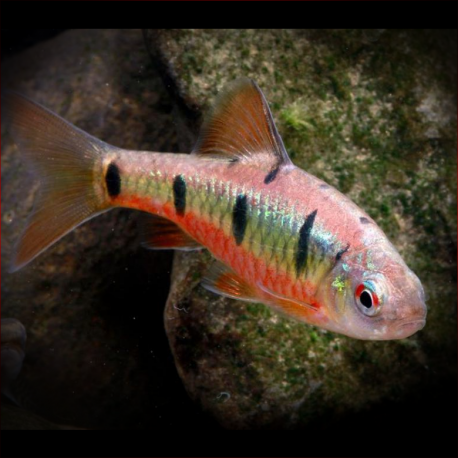More info
Datasheet
| Minimum Tank Size | 80 litres / 21.13 US gallons |
| Maximum Size | 7.5cm / 2.95inches |
| Temperature | 18°C / 64.40°F - 24°C / 75.20°F |
| Hardness | 2.02dgH / 36ppm - 20.00dgH / 357ppm |
| pH | 6.0-8.0 |
General Description
The Puntius snyderi, commonly known as the Green Snyderi Barb, is a species that closely resembles the P. semifasciolatus but with distinguishable differences in appearance. The natural color pattern of the Green Snyderi Barb is greenish with variably-arranged dark flank markings. It is a member of the Cyprinidae family and reaches a maximum size of 7.5cm.
Aquarium Setup
The Green Snyderi Barb thrives in a well-planted aquarium with a dark substrate and appreciates the addition of floating plants, driftwood, and branches to create a natural feel. It does well in a moderately filtered tank with some water movement, and a hill stream-type setup is suitable.
Behaviour
This species is known to be very peaceful and is an excellent addition to a community aquarium. When housed with similar peaceful cyprinids or other compatible species such as loaches and benthic cyprinids, the Green Snyderi Barb displays interesting interactions among rival males, showcasing vibrant colors during competitions for female attention or hierarchical status.
Feeding and Diet
As a foraging omnivore, the Green Snyderi Barb primarily feeds on benthic diatoms, algae, organic detritus, small insects, worms, crustaceans, and zooplankton in its natural habitat. In captivity, a diet of small live and frozen foods like bloodworms, Daphnia, and Artemia, combined with high-quality dried flakes and granules containing plant or algal content, ensures optimal health and coloration.
Reproduction & Dimorphism
Details about the reproduction habits of the Green Snyderi Barb remain unrecorded. However, sexually mature males develop red pigmentation on the lower body, while adult females are typically rounder-bellied and slightly larger than males.
Habitat and Distribution
The Green Snyderi Barb prefers shallow, marginal areas in slow-moving streams, irrigation canals, and ponds with dense aquatic or riparian vegetation. Its distribution includes central and northern Taiwan, where it coexists with the closely-related P. semifasciolatus, also found in mainland China.
Etymology
The species epithet "snyderi" honors American Zoologist John Otterbein Snyder (1867-1943) for his contributions to the field.

